Last Updated on 14/05/2024
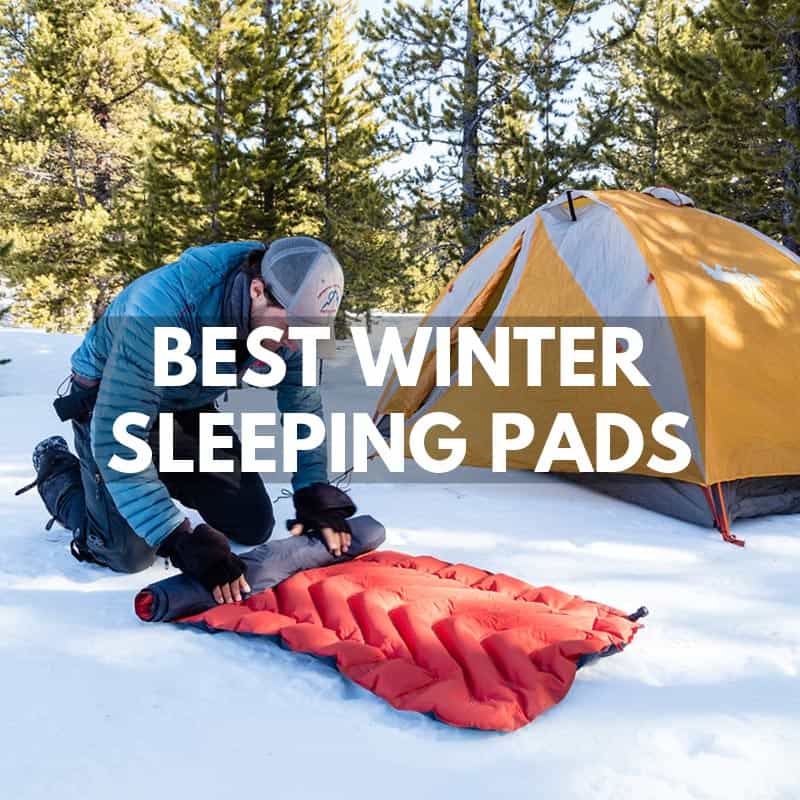
In this guide to the best winter sleeping pad, we share our recommendations for cold weather camping in freezing conditions. In addition, we explain what R-values for insulated sleeping mats mean and why they are essential to understand before camping on snow.
Sleeping bags are nice, but you will be at risk of freezing to death without a sleeping pad in winter.
When the temperatures drop below 30º Fahrenheit, and you plan to camp, you need a 4-season sleeping pad with insulation and a high R-value rating to keep you warm. For most people, this will be an R-value of 5, which will keep you warm beyond freezing temperatures.
We rounded up all the warmest camping mats out there and ranked them in terms of warmth, pack weight, and size. We also included notes on what we looked for and why further down.
9 Best Winter Sleeping Pads
Therm-a-Rest NeoAir Xtherm – Best Lightweight Winter Sleeping Pad
- R-VALUE: 6.9
- WEIGHT: 15 oz / 425 g
- DEPTH: 2.5 in / 63 mm
- DIMENSIONS: 72 x 20 in / 183 x 51 cm
- PACK SIZE: 9 x 4 in / 23 x 10 cm
The Therm-a-Rest NeoAir Xtherm is the best winter sleeping pad in all but one area. It is one of the warmest camping mats and, amazingly, also the lightest with the second smallest pack size. So it offers the best warmth-to-weight ratio and is among the top two easiest to pack. Even though it isn’t the thickest, we found the horizontal rides to be more comfortable than the traditional vertical baffles seen on the Exped pad below.
With an R-value of 6.9, the NeoAir Xtherm is suitable for freezing temperatures down to -26 F / -32 C and why it’s one of the most popular 4-season sleeping pads out there. The only warmer camping pad is the Exped Ultra range; however you can increase the R-value of any sleeping pad system by adding a second foam pad as an underlay.
The insulation uses strands of thermal foam layered between a Triangular Core Matrix of baffles to provide constant warmth with no cold spots. Out of sight on the inside of the sleeping bag, there is also a reflective thermal layer called Thermacapture to help trap warm air generated from body heat.
You can choose between two types of inflation valve; however you should use a pump where possible to avoid any moisture build-up on the inside. The one thing that it lacks in comparison to the other options is depth, which for side sleepers is a big deal. 2.5 inches is plenty deep to sleep on your side it’s just that this is on the lower end of the spectrum of what is available.
SUMMARY: The NeoAir Xtherm insulated sleeping pad from Therm-a-Rest is one of my go-to sleeping pads all year round but especially in winter and backpacking. It weighs so little for how much warmth it provides and if you are worried about getting cold but don’t want to carry anything heavy then this is for you.
Exped Ultra 8R Sleeping Pad – Best Cold Weather Sleeping Pad
- R-VALUE: 7.8
- WEIGHT: 33 oz / 935 g
- DEPTH: 3.5 in / 89 mm
- DIMENSIONS: 72 x 20.5 in / 183 x 52 cm
- PACK SIZE: 6.3 x 13 in / 16 x 33 cm
The Exped Dura 8R Sleeping Pad is among the warmest sleeping pads for winter camping. You can get it in a range of R-values that all have the same dimensions just with different amounts of insulation. The Dura 8R uses 700-fill-power goose down to insulate the mat which is how it stays so warm and light and packs down so compactly.
Because this sleeping pad is so warm and well insulated, it is the perfect mat to combine with a quilt or wool blanket because you don’t need any extra warmth beneath you. One problem with down sleeping bags is that when you lay on them the down compresses and loses some of its performance – a sleeping pad like this solves that problem. With it having down feathers inside, we highly recommend using a pump instead of your breath to inflate it and avoid any condensation spoiling the down.
At 3.5 inches deep, you will have no trouble sleeping on your side even if the ground is rocky or uneven. Speaking of rocky ground, the durability of this sleeping pad has been taken into serious consideration and we are very impressed. The fabric combines threads of 70D with much thicker 175D 100% recycled polyester for much better durability without excess weight.
SUMMARY: The Dura 8R Down Insulated Sleeping Pad from Exped is one of the best insulated sleeping pads in the world, rated down to an incredible 36 F / -38 C. If you are a cold sleeper or are camping in the coldest environments on the planet then this is what you want. It is the same sleeping pad used by expeditions and TV crews filming wildlife in the Arctic.
Sea to Summit Ether Light XT Extreme
- R-VALUE: 6.2
- WEIGHT: 25.5 oz / 725 g
- DEPTH: 4 in / 101 mm
- DIMENSIONS: 72 x 21.7 in / 183 x 55 cm
- PACK SIZE: 6.9 x 9.4 in / 17.5 x 24 cm
The Sea to Summit Ether Light XT Extreme has a high R-value of 6.2 and is even deeper than the Exped and Therm-a-Rest pads above. This winter sleeping pad also has a different baffle system which doesn’t use verticle or horizontal ridges and instead uses dozens of single-layer air sprung cell ‘bubbles’ like more of a patchwork. The final thing that makes this one of the best cold weather sleeping pads is the fact that it is 4 inches thick for lots of comfort.
This pad is so thick that you can inflate it only halfway and still sleep on your side without touching the ground. Inside the plush design is a double insulating system consisting of high-loft fiberfill and reflective fabric to help trap body heat. The insulation is lightweight, compactable, and very efficient at trapping heat – just like down but cheaper.
One thing I do wonder about these ‘bubble baffles’ (as I will now call them), is what happens to all the creases over time. I have seen the odd one pop up before on cheaper Chinese knock-offs but Sea-to-Summit has excellent customer service so it shouldn’t be an issue. Controversial thought – I don’t find this baffle style any better than horizontal or vertical.
SUMMARY: The Sea to Summit Ether Light XT Extreme is a nice balance of warmth, comfort, weight, and pack size. It isn’t the highest performer in any of these areas but it is consistently near the top for all of them which makes this a very reliable choice. You can get it in a women’s size/shape as well as in a more lightweight version with a lower R-value.
Exped MegaMat Max 15 Sleeping Pad – Warmest Sleeping Pad
- R-VALUE: 10.6
- WEIGHT: 122 oz / 3,458 g
- DEPTH: 6 in / 152 mm
- DIMENSIONS: 77.6 x 30.3 in / 197 x 77 cm
- PACK SIZE: 31 x 11 in / 79 x 28 cm
The Exped MegaMat Max 15 Sleeping Pad is the warmest sleeping pad with the highest R-value rating you can use for camping. Nothing even comes close to it. The only downsides are that it is absolutely massive and weighs a tonne. So it isn’t suitable for backpacking or hiking but for car camping, you can’t beat it.
It has an R-value of 10.6 which is a full 2 units more than its closest rival. This will keep you warm down to extreme temperatures of -54 degrees F thanks to the insulation inside which is an open-cell polyurethane foam that won’t let you down. The top surface is a 50D stretch tricot nylon which is super soft and comfortable while the sides and bottom are made from a tougher 75D polyester for durability.
At 6 inches deep and with a flat surface on top, this is as close as you can get to your mattress at home while you are camping. I am a side sleeper and you can let around 25% of the air out of it and still sleep like a log. I like to do this with all deep sleeping pads as I just tend to sleep better.
SUMMARY: The MegaMat Max 15 Sleeping Pad from Exped is the maximum amount of warmth and comfort you can find anywhere. Its pack size is bigger than many small tents and it weighs over seven times more than many other options. But that doesn’t mean it doesn’t belong here. This is the warmest there is and if that is what you want then you have to make sacrifices elsewhere.
Nemo Tensor Alpine Ultralight Mountaineering Pad
- R-VALUE: 4.8
- WEIGHT: 17 oz / 482 g
- DEPTH: 3 in / 76 mm
- DIMENSIONS: 72 in x 20 in / 183 x 51 cm
- PACK SIZE: 5 x 9 in / 13 x 23 cm
We feel like the Nemo Tensor Alpine Ultralight Mountaineering Pad is underselling itself with an R-value of 4.8. It feels much warmer than similar pads even when lying on the snow. It features a checkered baffle system that Nemo calls “Spaceframe” so that you get a very even surface with full hip and shoulder support as well as a much quieter sleep.
Instead of using any kind of down or synthetic foam for the insulation, the Tensor pad has 3 layers of Thermal Mirror metalized film inside which are extremely efficient at reflecting your body heat at you. You really have to try it to believe how warm it feels. The advantage of this type of flat insulation is that it packs down to almost nothing and allows it to stay very lightweight.
You might think that having internal foil for insulation would make it sound all crinkly when you sleep on it but it is surprisingly silent. Care has gone into the outer materials to make it feel extra soft and comfortable. A really nice feature is that they include an inflation sack which works better than most of the aftermarket ones you can buy.
SUMMARY: The Tensor Alpine Ultralight Mountaineering Pad from Nemo Equipment would be suitable for 4 seasons in many parts of the world. It is super comfortable and warm in winter temperatures and it seems to regulate your temperature very well in both hot and cold weather. The best thing about this once it passes the warmth test is the fact that it weighs less than 500 grams and packs down remarkably small. Slightly warmer than the Big Agnes Air Core below, we really like this pad and will probably do a separate review soon.
Sea to Summit Comfort Plus XT Insulated Air
- R-VALUE: 4.7
- WEIGHT: 35.8 oz / 1,015 g
- DEPTH: 3 in / 76 mm
- DIMENSIONS: 72 x 25 in / 183 x 63 cm
- PACK SIZE: 5.5 x 11 in / 14 x 28 cm
The Sea to Summit Comfort Plus XT Insulated Air is another winter sleeping bag that feels warmer than its 4.8 R-value rating. It has air-sprung baffles created by spot welds instead of seams so that you get a very even platform to sleep on. These air-sprung baffles seem to conform to your body better than other directional baffles.
The Comfort Plus XT Insulated Air Mat has two types of insulation including Exkin Platinum which is a reflective foil lining the inside of the chambers but doesn’t make any crinkly noises like emergency blankets. Then it also has Thermolite high loft synthetic insulation that prevents convective heat loss. This extra insulation does add a fair bit of weight but it is also what makes this a 4 season winter sleeping pad.
One feature we aren’t sure about is the fact that it has a valve on each side, does it really need it? Either way, the double valves are nice and wide with the first being a one-way inflation port and the second being for deflation. One feature we love is the storage sack which doubles as an inflation pump so that you don’t have to blow it up with your mouth and risk getting moisture inside.
SUMMARY: The Comfort Plus XT Insulated Air from Sea to Summit is incredibly reliable in cold weather and one of the comfiest 3-inch deep sleeping pads out there. It pairs very well with Sea to Summit’s other camping gear like the Aeros pillow or Ember Down Sleeping Quilt although if you are trying to save weight then check out the S2S Ether Light XT Extreme further up. This one is for winter comfort.
Big Agnes Insulated Air Core Ultra
- R-VALUE: 4.5
- WEIGHT: 22 oz / 598 g
- DEPTH: 3.25 in / 82 mm
- DIMENSIONS: 72 x 20 in / 183 x 51 cm
- PACK SIZE: 4 x 8.5 in / 10 x 22 cm
The Big Agnes Insulated Air Core Ultra is one of the warmest 3-season sleeping pads out there that you can use in mild winter conditions. What we like about this pad is its weight, warmth, baffle design, and inflation valve. It packs down super small and has solid credentials right down our list of features to look for.
The main part of the pad that you sleep on is 3.25 inches deep however the outermost baffle on each side is 3.5 inches deep which creates a cradle so you don’t roll off. This makes it incredibly comfortable to sleep on as it kind of hugs you whether you are on your side or on your back. While there isn’t much difference between the direction of baffles, we found these wide vertical chambers to be very comfortable.
It is insulated with reflective foil on the inside which helps to trap your body heat and prevent losing it through contact with the ground. Unlike pads with down insulation, it isn’t a problem to inflate this with your breath and the wide valve with an internal stopper means you can take a breath while inflating it. This valve stopper also makes it easy to control firmness by letting out little amounts of air at a time.
SUMMARY: The Insulated Air Core Ultra made by Big Agnes is a great mid-range sleeping pad that costs around half the price of the Nemo Tensor Alpine above and has very similar specifications. Overall it is incredibly comfortable and plenty warm enough for cold weather camping if you have a good sleeping bag. Perfect for backpacking.
KLYMIT STATIC V LUXE Sleeping Pad
- R-VALUE: 4.4
- WEIGHT: 16 oz / 453 g
- DEPTH: 2.5 in / 63 mm
- DIMENSIONS: 72 x 23 in / 183 x 58 cm
- PACK SIZE: 5 x 8 in / 13 x 20 cm
The KLYMIT STATIC V LUXE Sleeping Pad took the camping community by storm over a decade ago and this was one of the products that helped them do it. The Static V Luxe has a very unique baffle system with deep chambers running up either side and then a v-shaped system running down the main section. This makes it feel like more of a cot than a mat and even though it is only 2.5 inches deep in the middle the v-shape baffles support sideways sleepers like no other.
The Static V Luxe pad is also wider than most other regular sizes and if that isn’t enough for you, you can get this in an extra wide model that is 30 inches across. The extra width combined with the unique baffle design makes this one of our favorite winter sleeping pads to use inside a hammock as well as on the ground (including snow).
You can get it in an uninsulated version as well as an insulated one, however, the insulated version only has an R-value of 4.4 which is the lowest in this guide and not entirely suitable for freezing temperatures. Still, we included it in this list because it copes well in most cold weather and is by far the cheapest option in this guide.
SUMMARY: The STATIC V LUXE Sleeping Pad from KLYMIT is super lightweight, budget-friendly, and can just about cope with most cold weather. It has the least amount of insulation of any on this list and so you will need a good sleeping bag or some extra insulation in freezing conditions. But the cost and weight make it worth it in our opinion.
Nemo Roamer Double Sleeping Pad
- R-VALUE: 6
- WEIGHT: 120 oz / 3,401 g
- DEPTH: 4 in / 101 mm
- DIMENSIONS: 78 x 52 in / 198 x 132 cm
- PACK SIZE: 26 x 11 in / 66 x 28 cm
The Nemo Roamer Double Sleeping Pad is a beast. There is no other way of putting it. It is big enough for two people to stretch out on, deep enough so that you never feel the ground, and extra warm for winter camping. It is also quite heavy and bulky to carry.
There are lots of double air mattress options out there but very few are suitable for extreme cold and winter conditions. This one is. With a high R-value of 6 suitable down to temperatures of around negative thirty degrees Fahrenheit, you can be sure not to lose much body heat to the frozen ground at all.
At four inches deep you have lots of play to let some air out if you prefer a softer mattress to a firm one, and still comfortably sleep on your side. The top material is a silky soft and smooth 50D stretch fabric while the sides and bottom are more rugged with a 75D polyester composition. You can zip two sleeping bags together or use a double so that you and your partner can snuggle up for warmth on those romantic winter camping trips.
SUMMARY: The Roamer Double Sleeping Pad from Nemo is perfect for winter camping with a partner. Featuring a deep insulated mattress design without baffles and ridges on top, this is just like being at home. You can use it in the back of your car, on top of a double camping cot, or in your two-man tent. The weight isn’t so much of an issue if your partner carries the tent. Unbeatable on warmth and comfort in this category of insulated double sleeping pads.

What R-Value Sleeping Pad Do You Need for Winter Camping?
Based on the advice from multiple sleeping pad manufacturers and specialists, you need an R-value of at least 5 to safely camp in winter temperatures. This will provide enough resistance to stop you from losing body heat to the cold, hard ground.
Our advice would be to get as warm a sleeping pad as possible for winter camping and to add at least -10 degrees to the recommended temperature so that you are less likely to ever face being in a dangerous situation. And remember that there are other things to take into consideration other than weight.
Types of Sleeping Pad Insulation
Sleeping pads with an R-value of four and up will almost always have some kind of insulation inside to help keep you warm. Here are the different types of insulation you can choose from and in some cases get a combination of:
Reflective Foil
Reflective foil is the general term used to describe this type of insulation that prevents radiation and convective heat loss. It will line the entire inside of the air chamber and adds very little bulk or weight.
Unlike down feathers or synthetic insulation, the reflective foil has zero loft and is exceptionally thin so it packs down extra small and is very lightweight. It is similar stuff to that used in mylar emergency blankets but has been engineered to be almost silent so that it doesn’t crinkle as you move about.
Synthetic Insulation
Synthetic insulation, like that you would find in a winter jacket, is often used in winter air beds to add reliable warmth and reduce heat loss. It is typically something that mimics down by having high loft but being lightweight and compressible. The advantage that fibrous insulation has over foil alone is that it drastically improves the reduction of convective heat loss.
Synthetic insulation, while heavier than down, is often a better option because it is less likely to be affected by condensation that inevitably finds its way into any inflatable pad.
Down Insulation
Down insulation is always the most desirable because of its natural thermal qualities and incredible weight-to-warmth ratio. Most synthetic insulation is designed to emulate the same characteristics of down which should tell you something about its suitability. As well as being lightweight and warm, down can be compressed and then fluff straight back up, which is important when you are rolling your sleeping pad up for storage every morning.
The downsides of down insulation in sleeping pads are that it is very expensive and vulnerable to moisture. So you need to avoid blowing it up with your breath, which contains lots of moisture and use an inflation device instead. Thankfully, most down-filled sleeping pads now come with a storage sack that doubles as an inflation bag which helps.

Guide to The Best Winter Sleeping Pads for Cold Weather Camping
When trying to decide which sleeping pads are best for winter, we had to think about lots of different scenarios in which they would get used. We decided that the most important things were the R-value, weight, pack size, and comfort, but other things came into play too. Here is a breakdown of our baseline considerations when choosing a sleeping pad for hiking, backpacking, and winter camping:
R-Values and Warmth
R-values are now standardized by law for sleeping pads, and so you can rely on them to be fairly, if not totally, accurate. You can use R-values to judge the temperature limits they will be suitable for using our chart here.
When camping on snow or in the minuses then comfort, weight, and pack size come second to the warmth of your sleeping pad is the most important thing. If you want to stay lightweight, then foil-type insulation will work best, but in extreme conditions, you will likely need more than just foil and should then decide between down or synthetic.
Comfort
In order to get a good night’s sleep, you need to be comfortable as well as warm. This means choosing a baffle system that works for you and finding the right depth. We found that 2.5 inches is just enough to sleep on your side, but anything above 3 inches deep is the sweet spot where you won’t sink down so much that you touch the ground beneath.
To make sure we were being fair, we tested all the different baffle designs side by side to see which was the comfiest. We first tested them at full inflation and then partially deflated. In all but the Nemo Roamer and Exped MegaMat, which don’t have baffles, we found that all other sleeping pads were more comfortable with around 10% – 25% of the air let out.
Pack Size
Pack size is more important to some people than others. If you want the best winter sleeping pad for backpacking and hiking, then you will be limited on space inside your backpack, so the smaller your camping gear is, the better. The smaller pack sizes are around 9 x 5 inches which are about the size of a water bottle and very manageable. The larger pack sizes will take up a significant portion of your backpack and limit the other supplies you can carry.
Pack Weight
Much like pack size, the weight of your packed sleeping pad matters mostly for backpackers, hikers, and anyone who is carrying their equipment on their back. For me, being lightweight is crucial on long-distance hikes, so I look for a pack weight of around 16 – 20 ounces. For other people, warmth and comfort are more important, and so they will be willing to carry a much heavier pad.
Side Sleeping
Side sleepers need deeper sleeping pads than people who sleep on their backs, especially in winter. We recommend a winter sleeping pad depth of at least 2.5 inches but preferably three inches for side sleepers.
According to a national sleep study done by Anna’s Linens’ research department, almost 3 out of 4 people sleep on their side as opposed to their back or front. For thinner inflatable sleeping mats, this can be a problem because your body weight will concentrate on your hips and shoulders so that you sink down and end up touching the ground.
This means that you will not be able to get comfortable very easily or let any air out of your mat to make it less firm, and it also means that you could lose a significant amount of body heat through your contact with the ground.
Insulation
As we covered in a bit more detail further up the guide, there are three main types of insulated camping mats to choose from; reflective material, synthetic insulation, and down/feather filling. All three have their pros and cons, but we found the warmest sleeping pads combine the reflective lining with either synthetic or down filling.
Down is by far the most expensive but offers an unbeatable weight-to-warmth ratio. Synthetic is more budget-friendly and reliable but will be heavier and often bulkier.
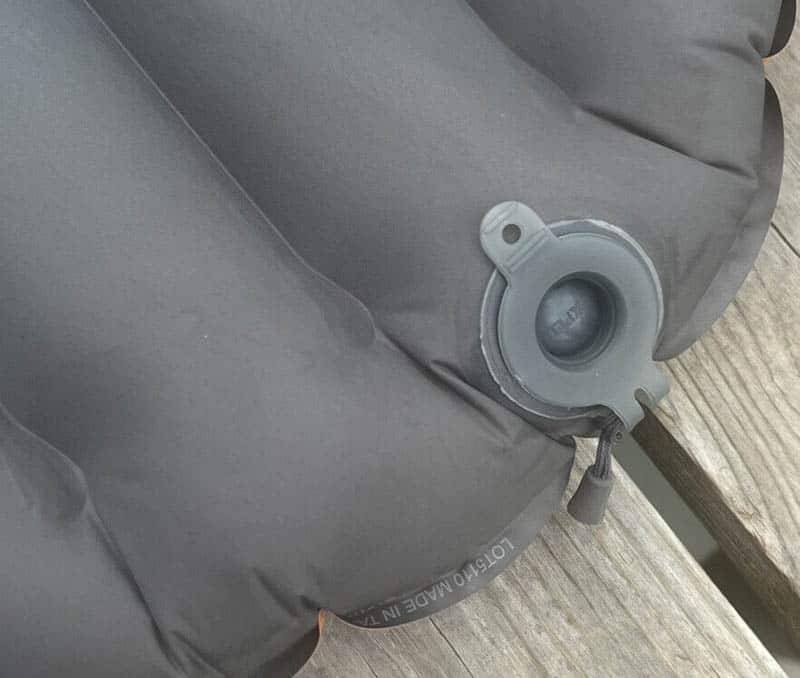
Inflation and Valves
We have tested dozens of sleeping pads over the years, and one feature we never used to pay much attention to was the inflation valve and how easy it is to inflate and deflate the pad. What brought this to our attention was a mid-range sleeping pad that had a terrible valve design. It would get caught on the sleeping bag and come open in the night, leading to waking up cold and having to reinflate it when you should be catching z’s.
When the inflation port is on the side of the pad, you don’t have to worry about knocking it undone at night, but if it is on the top of the pad, then it will need to have some kind of secure attachment. Screw valves work best for this. The manufacturers that have nailed the design of inflation valves on sleeping pads are Thermarest, Nemo, Sea to Summit, and Exped.
A great insulated sleeping pad will have a one-way valve for inflation so that you don’t lose any air as you are inflating it and also a two-way valve to deflate your pad easily. The one-way valve should also double as an air control adjuster so that you can let tiny amounts of air out to find the perfect firmness.
Durability
One of the big fears most people have with using an inflatable sleeping pad in winter is the fact that a puncture can make it unusable (if you don’t have a repair kit). I had this fear for many years, too, but after spending hundreds of nights camping on all kinds of rough ground, I have become way more trusting. I have never had a puncture (touch wood), but I have seen two other people struggle with it. In both cases, a simple adhesive puncture patch solved the problem in less than five minutes once we found the hole.
Something you can look for is what materials are used and specifically what dernier fabric. The dernier of a fabric describes how thick the fibers are, which can help you determine the toughness. For example, many lightweight down jackets will go as low as 10D fabric, while you will see many tents using 200D fabric and upwards. We found that 75d fabric on the bottom of your sleeping pad provides more than enough durability and protection against sharp surfaces.
Dimensions
We have covered how the depth of a sleeping bag can have a massive impact on your comfort and how well you sleep, but the width and height should also be considered. While we don’t recommend putting your sleeping pad inside your sleeping pad, if you did want to, you would need to check that the dimensions match your requirements.
If you are in good shape and of average height, then you don’t have to worry. If you are big and tall, XL options are often available as the most premium choices. If you are short or quite petite, then you may be able to save weight and money by using a 3/4-length pad. The reason we didn’t include any short pads is that in winter, you don’t want your feet to hang off the end, or they will get very cold at night.
Noise
One thing that you can’t look for but can test is how noisy is your sleeping pad when you move about on it. Does it crinkle like a packet of chips or is it soft and flexible? The only way to find out is to test it or read reviews online.
Most people won’t even think of this being an issue, but if you have ever laid awake at night in your tent, unable to sleep, then things like the noise it makes and how loud it is can become a fixation that prevents you from getting back to sleep. I personally think that Nemo sleeping pads have tackled the problem better than others and their pads are very smooth, soft, and silent when you move about.
Generally, if a sleeping pad has a different top fabric to the bottom and sides, this will be designed to make as less noise as possible. With winter sleeping pads that have a thermal reflective lining, you might think they will be even noisier. But because the noise issue became apparent early on, they are now developed to be very quiet to move about on.
Value and Budget
Last but not least is how much it costs for an insulated sleeping pad vs a non-insulated one. Firstly, it is more expensive as more materials are used as well as extra, often complicated, steps in the manufacturing process.
We found that most of the highest performers were around the $150 – $300 range at the time of writing this. You don’t have to spend that much if you are on a tight budget though. The KLYMIT STATIC V LUXE and Big Agnes Air Core Ultra Insulated sleeping pads are priced around or below the $100 mark.
You can also get thousands of different cheap options at the supermarket and online retailers that may cost closer to $50, but we recommend you avoid these. You might get lucky and buy one that lasts many years, but this seems to be a rarity for any kind of outdoor gear used regularly.
The opposite is true with the tried and tested options we recommend – it is rare to get one that fails, and if it does, these well-established companies have some of the best customer services out there. They will often fix or replace your pad for free.
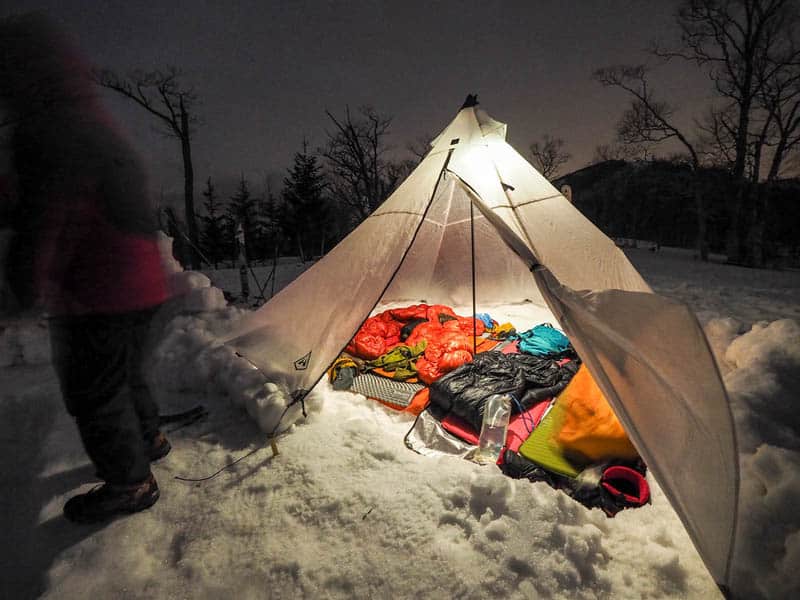
Can R-Value Be Too High on a Sleeping Pad?
In winter, I find it hard to believe you could ever have an R-value that is too high on a sleeping pad. In summer, a high R-value sleeping mat might get a bit hot but never to the point that it becomes unbearable – you just unzip your sleeping bag or stick your legs out to cool down.
Do Sleeping Pads Keep You Warm?
An insulated winter sleeping pad can keep you warm in two ways: by limiting radiative heat transfer with reflective foil or by limiting convective heat transfer with synthetic or down-fill insulation.
Some people think that it is sleeping bags that keep you warm in a tent, but without a sleeping pad, your sleeping bag will only keep you warm from the top. Sleeping pads are what keep your underside warm, and they serve a very important role in resisting heat loss through the ground. If you can’t prevent losing heat through the frosty ground, you won’t last very long in winter.
Is R-Value 2.5 Good for A Sleeping Pad?
The R in R-value stands for resistance which is a sleeping pad’s main role in winter. R-values range from 0 to over ten and represent the thermal powers of the insulation. An R-value of 2.5 is good for late spring, summer, and early autumn, but in winter, you will need something higher. We recommend a minimum R-value of 4 – 5, but ideally, you want to go as warm as possible.
Does Deflating Your Sleeping Pad Reduce Insulation?
If you like to sleep on a partially deflated sleeping pad for extra comfort, you may lose a small amount of R-value, although I don’t have access to one of Thermarest’s testing facilities to confirm this. My thinking is that with less volume inside to insulate, the worse it will perform, but by how much, I am not sure.
The better option in winter may be to combine your inflatable pad with a foam mat which will lift your r-value and comfort.
How Much R-Value Will a Foam Sleeping Pad Add?
Foam sleeping mats with an average depth of 2 inches will typically have an R-value of 1.5 to 2.2, and so by adding one to your air mattress, this is how much you can increase your R-value. Is it worth doing? If your sleeping pad or bag isn’t very warm, then absolutely.
Another advantage of combining a foam pad with your air mattress is that it adds an incredible amount of durability and protection against thorns on the ground. The disadvantage is that foam pads are very bulky and so need to be strapped to the outside of your backpack.
We hope you enjoyed reading this guide to the best winter sleeping pad and found some of our advice useful. Please get in touch via the comments box with any questions, or if you disagree with anything I have written.



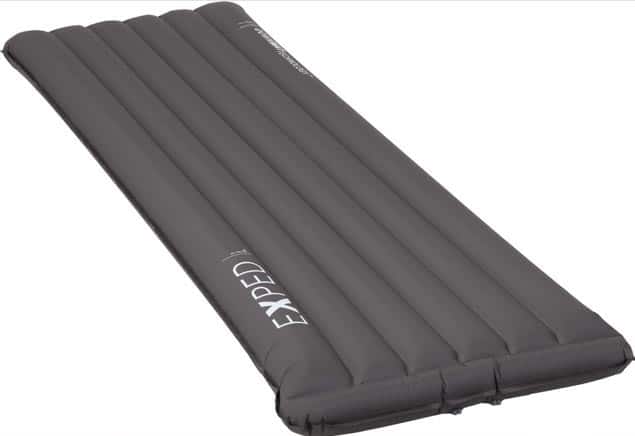










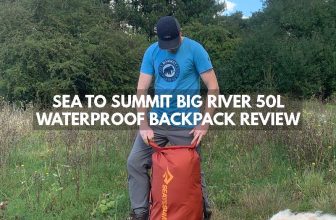
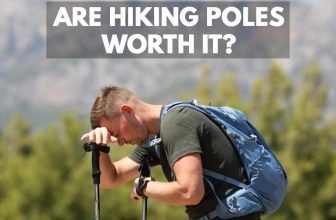

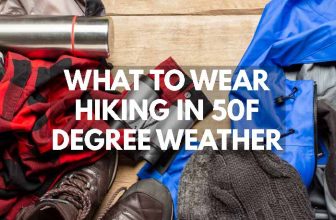
[…] should also mention early on that as well as a sleeping bag, an insulated sleeping pad is essential to stay warm when sleeping on the ground. You should normally use […]
[…] want some kind of insulation if you don’t want to feel cold. In winter you will need an insulated sleeping pad, an uninsulated sleeping pad won’t cut […]
[…] wearing socks. One last (small) thing is that on the underside it has some straps that fit your winter sleeping pad through so that it always stays in position with the hood at the […]
[…] Sleeping directly on the ground without a camping mat might be ok in summer when the ground doesn’t get too cold and there isn’t much dampness around. But anytime the temperature drops below 60 degrees at night, you will begin to lose body heat through the ground and feel cold. It doesn’t matter how warm your sleeping bag is, the ground will drain any heat you generate without an insulated sleeping pad. […]
[…] Winter Sleeping Pads […]